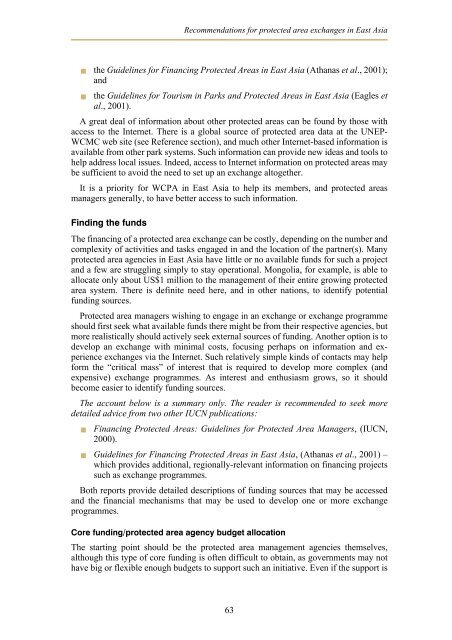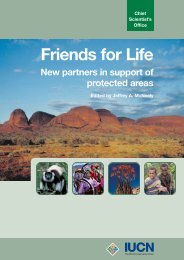Exchange programmes - IUCN
Exchange programmes - IUCN
Exchange programmes - IUCN
Create successful ePaper yourself
Turn your PDF publications into a flip-book with our unique Google optimized e-Paper software.
� the Guidelines for Financing Protected Areas in East Asia (Athanas et al., 2001);<br />
and<br />
� the Guidelines for Tourism in Parks and Protected Areas in East Asia (Eagles et<br />
al., 2001).<br />
A great deal of information about other protected areas can be found by those with<br />
access to the Internet. There is a global source of protected area data at the UNEP-<br />
WCMC web site (see Reference section), and much other Internet-based information is<br />
available from other park systems. Such information can provide new ideas and tools to<br />
help address local issues. Indeed, access to Internet information on protected areas may<br />
be sufficient to avoid the need to set up an exchange altogether.<br />
It is a priority for WCPA in East Asia to help its members, and protected areas<br />
managers generally, to have better access to such information.<br />
Finding the funds<br />
The financing of a protected area exchange can be costly, depending on the number and<br />
complexity of activities and tasks engaged in and the location of the partner(s). Many<br />
protected area agencies in East Asia have little or no available funds for such a project<br />
and a few are struggling simply to stay operational. Mongolia, for example, is able to<br />
allocate only about US$1 million to the management of their entire growing protected<br />
area system. There is definite need here, and in other nations, to identify potential<br />
funding sources.<br />
Protected area managers wishing to engage in an exchange or exchange programme<br />
should first seek what available funds there might be from their respective agencies, but<br />
more realistically should actively seek external sources of funding. Another option is to<br />
develop an exchange with minimal costs, focusing perhaps on information and experience<br />
exchanges via the Internet. Such relatively simple kinds of contacts may help<br />
form the “critical mass” of interest that is required to develop more complex (and<br />
expensive) exchange <strong>programmes</strong>. As interest and enthusiasm grows, so it should<br />
become easier to identify funding sources.<br />
The account below is a summary only. The reader is recommended to seek more<br />
detailed advice from two other <strong>IUCN</strong> publications:<br />
� Financing Protected Areas: Guidelines for Protected Area Managers, (<strong>IUCN</strong>,<br />
2000).<br />
� Guidelines for Financing Protected Areas in East Asia, (Athanas et al., 2001) –<br />
which provides additional, regionally-relevant information on financing projects<br />
such as exchange <strong>programmes</strong>.<br />
Both reports provide detailed descriptions of funding sources that may be accessed<br />
and the financial mechanisms that may be used to develop one or more exchange<br />
<strong>programmes</strong>.<br />
Core funding/protected area agency budget allocation<br />
Recommendations for protected area exchanges in East Asia<br />
The starting point should be the protected area management agencies themselves,<br />
although this type of core funding is often difficult to obtain, as governments may not<br />
have big or flexible enough budgets to support such an initiative. Even if the support is<br />
63






